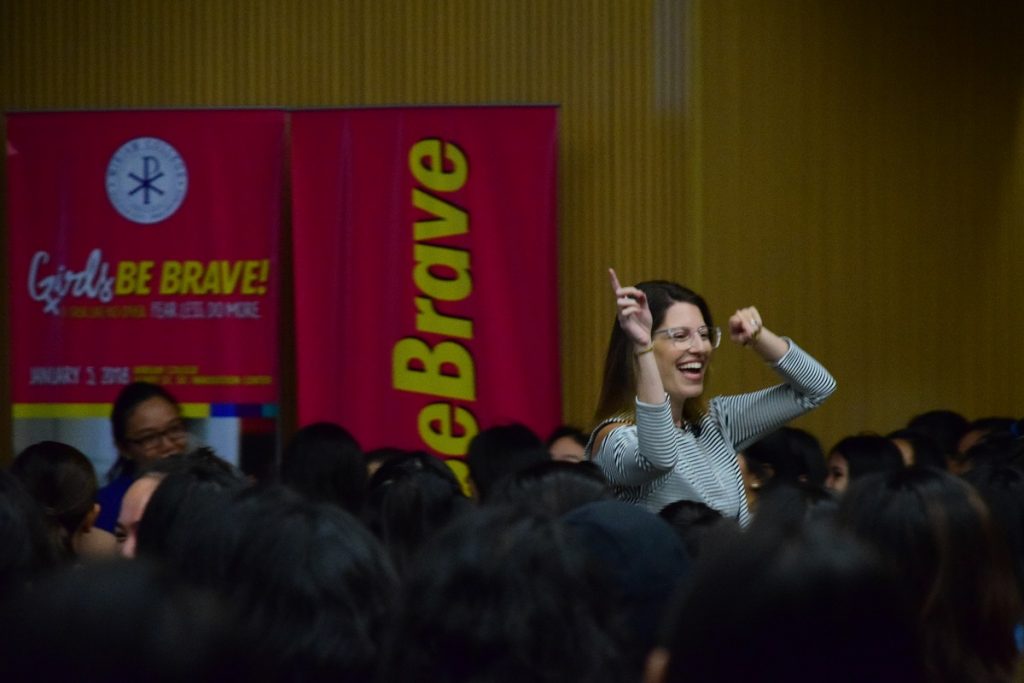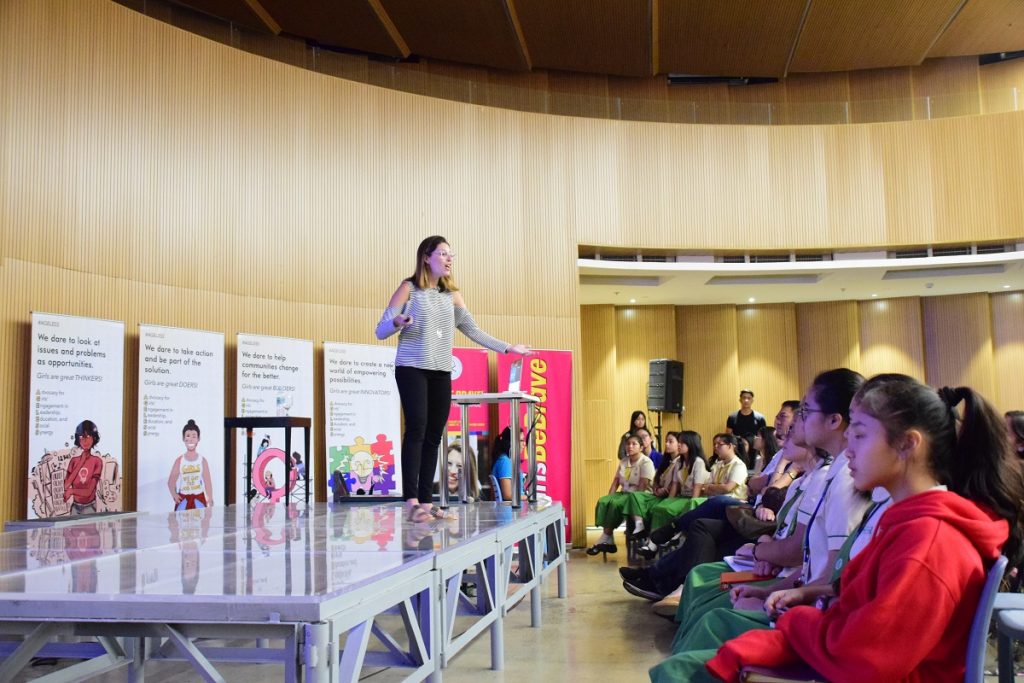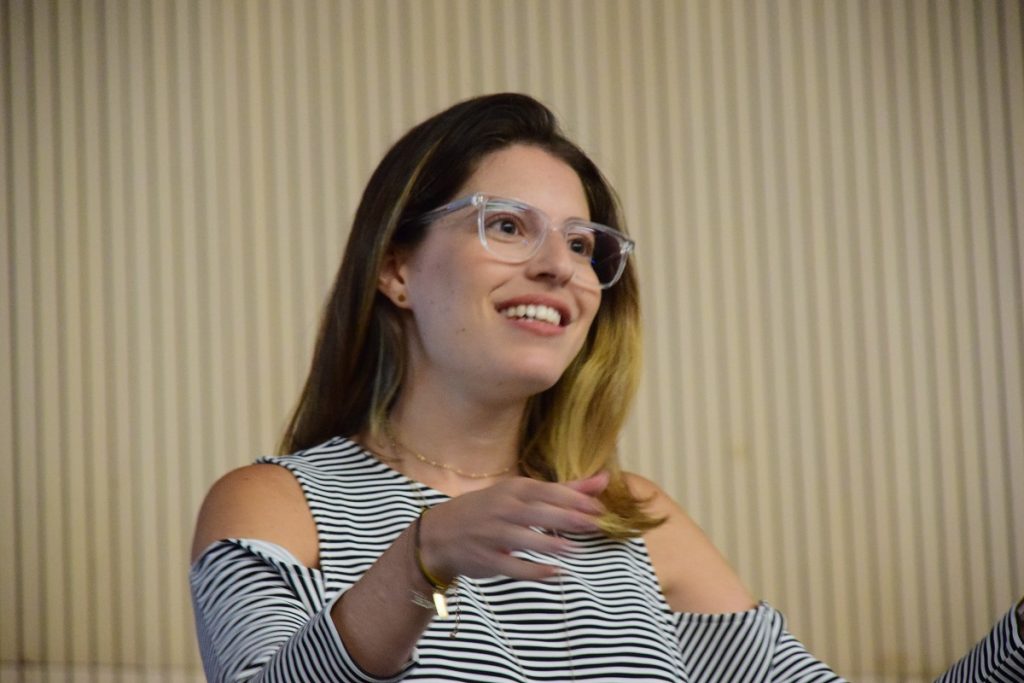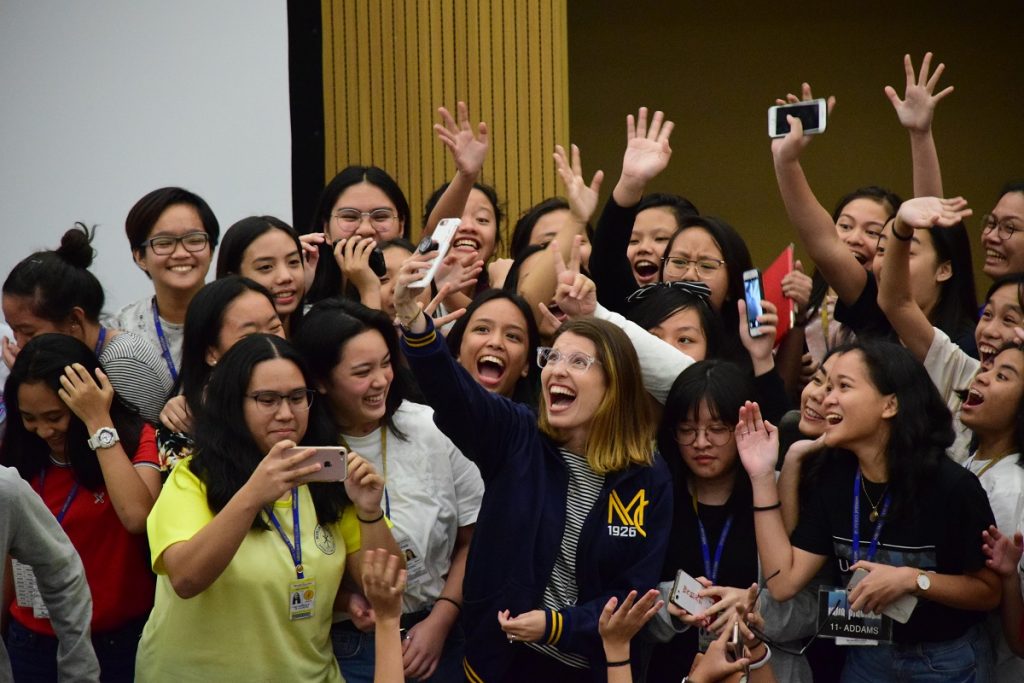
Walking down the aisle in a pretty dress with an entire congregation staring at you was not then three-year-old Michelle Poler’s idea of a good time. As a flower girl, she was terrified to walk by herself and lose sight of her mother.
She continued to be afraid to leave her parents’ side throughout her childhood in Venezuela, and was only at ease when they were near. By the time she was seven, they suspected it was more than an emotional condition. True enough, they brought her to the doctor and found out that she had a problem with her eyesight.
As she grew up, so did the list of things she was afraid of expand. She avoided big dogs – and by extension, friends who owned them. Roller coasters weren’t a thrill. Even eating oysters was a no-no.
“We all have a comfort zone,” Poler said, speaking on Friday, January 5, to teenage girls at Miriam College as part of the school’s “Girls Be Brave!” campaign, which aims to encourage female students to face subjects they fear so they can grow up to become innovators and leaders.
As a teen, she embraced her comfort zone and accepted the fact that these dictated her limits. “Every single decision I made was based on fear,” she said. Poler was afraid to feel fear, even.
As an excuse for staying away from uncomfortable situations, she thought to herself, TGIF: “Thank God I’m Female.”
“If I was a boy, I would have been bullied like crazy for being so fearful. I grew up thinking it was okay for girls to have fears and show them, while boys, boys should be strong, brave, and tough,” she said.
But boys and girls are equally scared. The difference is, society allows girls to show it, and expects boys to hide it.
Poler realized that she was being “cowardly sexist” toward her own gender just so she could shelter herself from the world.
She followed her dreams and moved to New York City, where she attended graduate school. But she couldn’t enjoy life in the Big Apple. Her fears caused her to miss out on “once in a lifetime experiences, on friendship, on life.” Basically, she said, “I was missing out on New York.”
In a stroke of serendipity, she and her classmates received an assignment for one subject: start a 100-day project of their choice, doing one thing that would lead to their growth repeatedly for 100 days in a row.
“I wanted to become a braver person. So that’s why I decided to face 100 fears in 100 days and document the entire process on YouTube,” Poler recounted.
For Day 51, she decided to face her fear of singing in public. She went to a club where there was a band, a stage, and a crowd. As she went through a list of songs, she realized that the only one she knew was a formidable one: “Rolling in the Deep” by Adele.
“My heart was about to jump off my chest when they called me on stage,” Poler narrated. “But I was there and I was determined to face my fear, so I went out there and grabbed my mic, started my song, and shortly after, I realized how bad of a singer I am! Way worse than what I thought! And I still had to go through the entire song! Those were the longest three minutes and 49 seconds of my life.”
And that was just the easy part. Afterwards, she had to go home, sit through her “horrible footage,” edit her video, and upload it for the entire world to see.
“Uploading the videos on YouTube was a whole fear by itself,” she said. The popular site can be “extremely intimidating,” but also a “powerful tool” that can allow people to teach, entertain, or inspire others.
“It’s thanks to YouTube that my project resonated with millions,” Poler said. On Day 40, she woke up and realized that every single website she followed had already shared her story. Even celebrities like Ashton Kutcher, Sofia Vergara, and Li’l Wayne were impressed.

Poler documented her first time crowdsurfing, where she recalled being close to passing out before the band called her to the stage. But once she’d finally threw herself into the arms of the audience, she felt “100 percent happy to let go and not be in complete control of the situation.”
She also shared how she decided to approach homeless people to ask them what she could do for them instead of just giving cash.
“Something remarkable happened that day,” she said. The first person she approached, a man, asked her if she could help a woman sitting across the street instead. He was concerned because she looked hungry.
“I was surprised beyond belief; I was asking him what can I do for him. And he’s asking me to help someone else? So I was shocked and even ashamed to think that this was a fear in the first place – to approach another human being on the street,” Poler said.
So she crossed the street and approached the woman, who asked her to buy food… for her starving cats.
“I realized that they may have no material goods, but kindness and empathy are things that we cannot just buy,” Poler said.
Another fear she conquered was being by herself. On Day 83, she challenged herself to travel solo in a new city, Washington D.C. Instead of giving in to her instinct – which was telling her to go back home to New York, crying – she decided to find a place where she could have lunch, and visit a couple of museums afterwards.
“I felt like I was in contact with myself, listening to my own thoughts and enjoying my own company,” she said.
She also went skydiving on Day 65, despite it being one of the things that scared her the most. Strapped next to a professional – Mike – who would control their parachute, she decided to trust in God, herself, and Mike. Then, plane door open, they jumped into nothingness.
“I was able to enjoy every second of that experience,” Poler said.
But the most fun she had was when she decided to dance in the middle of Times Square like no one was watching on Day 49. With her music player and earphones on, she was the only one who could hear what she was dancing to. But as soon as she was able to let go of her embarrassment, she started to enjoy the music and the moment. Other people started joining in – something she didn’t expect at all – and they partied in the street. She made friends too, and that video became one of the most memorable on her YouTube channel.
Countless people sent her messages thanking her for her project, saying it changed their lives and their view of fear. Her personal project to help her become a braver person was now inspiring people across the globe.
These were the people who understood that there is no such thing as being fearless, Poler said. Rather, there is bravery, which means “that despite the fear, you have the courage to take action. And that is way more powerful than being fearless.”
But there were also trolls. She was shocked at first, and felt bullied and attacked by their comments.
“But then I asked myself: who are these people? Are they also doing cool projects, sharing them online, impacting people’s lives, getting uncomfortable like I was? And the answer was no. These were people sitting comfortably behind the screen, trying to make me feel bad. So in that moment I decided that I would only listen to those who were also looking towards something – inspiring people, getting vulnerable like I was. So very quickly I went from feeling judged to feeling empowered to go after my biggest fears, which, by the way, were the ones that I enjoyed conquering the most,” she said.

To cap off her project, she gave a TEDxHouston talk, going beyond a physical fear to one that she felt would have a more meaningful impact. She shared her story to the world, and that decision gave her confidence and marked the beginning of her speaking career.
After facing more than 100 fears, she found that not once was the actual event as bad as what she thought it would be. So she wondered, “Why are we so afraid?”
There are fears that are tied to the need to survive, like the fear of heights or spiders. Other fears are related to the need for love and belonging, with society dictating the do’s and don’ts.
For Poler, she started to feel like life was a checklist she had to go through according to others’ expectations: go to college, find a job, get married, buy a home, and have kids.
“Until it hit me: who am I checking these boxes for? Who am I truly living for?” she asked. “I can say I’m comfortable, but can I say I’m genuinely happy?”
It was then that she realized that she could continue checking society’s boxes, or muster the courage to create her own boxes – move to New York, give a TEDx talk, become an entrepreneur, travel the world, leave an impact – and pursue them.
“I want you to think about what would your boxes look like,” she told the audience. “And if you weren’t afraid to disappoint others, what are some of the things that you’d like to accomplish in the next few years?”
She continued, “Belonging can be amazing. It’s what enables communities, friendship, team-building, family. But if we’re not careful, our need to fit in may hurt our authenticity.”
Poler also discovered that other fears stem from an aversion to failure. “But after embracing this new lifestyle where daring is my first choice, what I learned is that the enemy of success is not failure – it’s comfort,” she said. “Comfort is what keeps us from raising our hands to suggest the next big idea. It convinces us to stay with partners or friends we no longer love, and in places we cannot get much out of. Comfort begs us to watch one more episode instead of facing the blank canvas on our blog. And it tells us things like good things come to those who wait. But one day, you’ll get tired of waiting.”
When she started her project, she would always ask herself, “What’s the worst that could happen?” But the problem with the question was, it would only bring negative thoughts to mind. It was only when she decided to ask “What’s the best that can happen?” instead that she began to see the possibilities that were hiding behind each of her fears.
Through every decision life throws at her, she asks, “Which one is the growth choice? And then, pick that one despite the fear that it may bring.”
“Sometimes the growth choice is the scarier one,” she said. “So if you’re thinking about your next move and you feel the fear, you’re probably on the right track.”
This year, her plan is to write her own book. “Which terrifies me because I’m not a writer, but I do feel I have a story to share that can impact other people’s lives.”
“The more uncomfortable that we get, the greater the reward. It’s only when I got really uncomfortable and decided to face my fears that I started to see real impact. Halfway through my project, I realized that… I was inspiring other people just by facing my own fears,” she said.
True enough, people told her of their fears of starting over at 29 years old; of switching careers; of starting from scratch for the second time; of moving away from home; and of writing to someone they had not spoken to for a long time.
And they faced all these fears, telling her it made them feel free, grateful, or fantastic. “I have done more living in the last three years than I have in 33,” said one. Another said they felt “more like myself than I have in a really long time.”
“Courage begins with the will to think about the best-case scenario,” Poler said. “It’s about creating your own luck. Sending that e-mail or raising your hand to propose an idea. It’s what gets us what we deserve, and sometimes, even more. And courage is what will make you sweat at first. But then, puts that huge smile on our face. And just like a smile, courage is contagious. So what started as a personal development project turned into my purpose, a social mission to encourage people all over the world to say hello to their fears, through a mix of live events, video series, merchandise, and daily inspirational posts, we’re getting uncomfortable to make the world a braver place.”
And she left her audience with this question: “What would you get uncomfortable for?”










